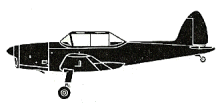
ASN Wikibase Occurrence # 20418
This information is added by users of ASN. Neither ASN nor the Flight Safety Foundation are responsible for the completeness or correctness of this information.
If you feel this information is incomplete or incorrect, you can submit corrected information.
| Date: | Tuesday 20 July 1954 |
| Time: | day |
| Type: |  de Havilland Canada DHC-1 Chipmunk T.10 |
| Owner/operator: | 63 Gp CF RAF |
| Registration: | WB747 |
| MSN: | C1/0194 |
| Fatalities: | Fatalities: 0 / Occupants: 2 |
| Aircraft damage: | Destroyed |
| Location: | Bagillt sandbank, Dee Estuary, 1 mile NW of Flint, Flintshire -
 United Kingdom United Kingdom
|
| Phase: | Manoeuvring (airshow, firefighting, ag.ops.) |
| Nature: | Military |
| Departure airport: | RAF Hawarden, Flintshire (EGNR) |
| RAF Hawarden, Flintshire (EGNR) | |
| Confidence Rating: |
de Havilland Canada DHC-1 Chipmunk T.10 WB747: Delivered 9/11/50. RAF Service was with 14 RFS, 9 RFS, and 63 Group Communications Flight.
Written off (damaged beyond repair) 20/7/54: The aircraft was put into a spin from an altitude of about 5,000 feet, as a demonstration in 'spin recovery techniques' to the Air Cadet passenger. Despite the appropriate spin recovery action being taken, the Chipmunk did not recover from the spin, and crashed onto the Bagillt sandbank on the River Dee Estuary, one mile North West of Flint, Flintshire. Both persons on board (pilot and one passenger) were injured, but were rescued.
According to a contemporary local newspaper report (Liverpool Echo - 21 July 1954)
"TWO SAVED FROM PLANE ON SANDBANK
Two occupants of a Chipmunk plane from Hawarden R.A.F. Station had a remarkable escape when they crashed on to a sandbank on the six miles-wide estuary of the River Dee at Flint yesterday [20-7-1954], fortunately the tide was out at the time. The injured men were trapped in the cockpit and would have been drowned, as the aeroplane was completely submerged when the tide came in again two hours later. The plane was piloted by Group Capt. H. C. S. Pimblett, senior medical officer of No. 63 Group. R.A.F., Hawarden. His A.T.C. Cadet passenger J. S. Howell. belongs to No. 2219 (Greenhall Grammar School) Squadron, Tenby, Pembrokeshire, which is in camp at Hawarden. Although the plane crashed some distance from the shore, rescuers were quickly on the scene, the first being Evan Andrews of Queen's Avenue, Flint; Davis Barker, Salisbury Street, Flint; Ronald Hilton, Chester Street, Flint; and Hugh Fox, Henry Taylor Street, Flint; who were working on the roof of a local factory.
CROSSED QUICKSANDS
They saw the plane coming down in a spin at a height of about 100 ft. and it disappeared out of sight over the marshes of the river. The four immediately left their work, and after removing their shoes and socks, they crossed a considerable distance of marsh land, and about a mile of treacherous quicksands, to reach the plane, which had made a pancake landing on the edge of the deep water channel. The four men were joined by Police-constables J. Harris and M. Harris, of the Flint Police, and they found the two occupants of the aeroplane injured and trapped in the cockpit. To release them the rescuers had to rip away the hood and a part of the cockpit dashboard and controls with their bare hands. They were joined by members of Flint Fire Brigade, who assisted in the work of extricating the men.
EQUIPMENT REMOVED
Police-inspector B. Roberts, Flint, organised stretcher parties and the injured men were carried a considerable distance to a waiting ambulance which conveyed them to Flint Cottage Hospital, after medical attention on the spot. High ranking R.A.F. officers with personnel arrived on the scene but, in a race with the tide, found it impossible to salvage the aeroplane because of the incoming tide. A quantity of equipment and some instruments were removed. Before leaving the scene, Wing Commander Fraser personally thanked and complimented those who had taken part in the rescue."
Crew of Chipmunk WB747
Group Captain Hugh Cuthbert Sutcliffe PIMBLETT, M.D., B.S., RAF (pilot)
ATC Cadet J. R. Howells (passenger)
The wreckage of Chipmunk WB747 was recovered from the crash site, and struck off charge as Cat.5(scrap) on 4/8/54 at 48 MU RAF Hawarden
Sources:
1. Liverpool Echo - 21 July 1954
2. Halley, James (1999) Broken Wings – Post-War Royal Air Force Accidents Tunbridge Wells: Air-Britain (Historians) Ltd. p.161 ISBN 0-85130-290-4.
3. Royal Air Force Aircraft WA100-WZ999 (James J Halley, Air Britain, 1985 p.21)
4. Category Five; A Catalogue of RAF Aircraft Losses 1954 to 2009 by Colin Cummings p.74
5. http://www.ukserials.com/results.php?serial=WB
6. "Wrecks in The Dee Estuary": https://www.liverpool.ac.uk/~cmi/dee/wrecks/wrDee.html
7. http://www.planetrace.co.uk/1950-1959_26.html
Revision history:
| Date/time | Contributor | Updates |
|---|---|---|
| 01-Jun-2008 17:53 | JINX | Added |
| 07-Jun-2008 22:20 | JINX | Updated |
| 01-Sep-2011 00:08 | melvilla1903 | Updated [Total fatalities, Total occupants, Other fatalities, Phase, Departure airport, Destination airport, Source] |
| 09-Nov-2018 16:48 | Nepa | Updated [Operator, Departure airport, Operator] |
| 16-Apr-2020 20:11 | Dr. John Smith | Updated [Time, Operator, Location, Departure airport, Destination airport, Source, Narrative] |
| 16-Apr-2020 20:44 | Investig | Updated [Operator, Operator] |
Corrections or additions? ... Edit this accident description
The Aviation Safety Network is an exclusive service provided by:


 ©2024 Flight Safety Foundation
©2024 Flight Safety Foundation